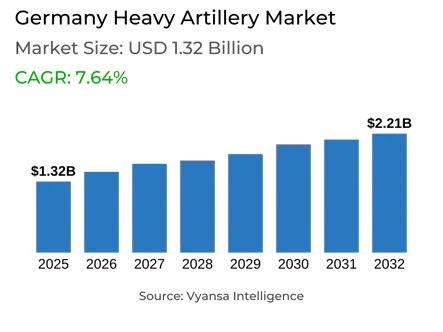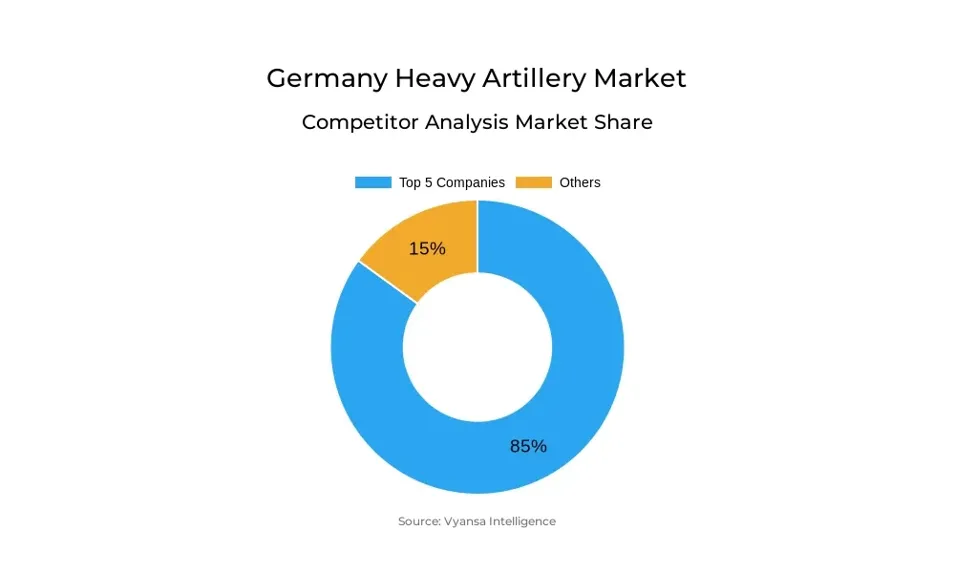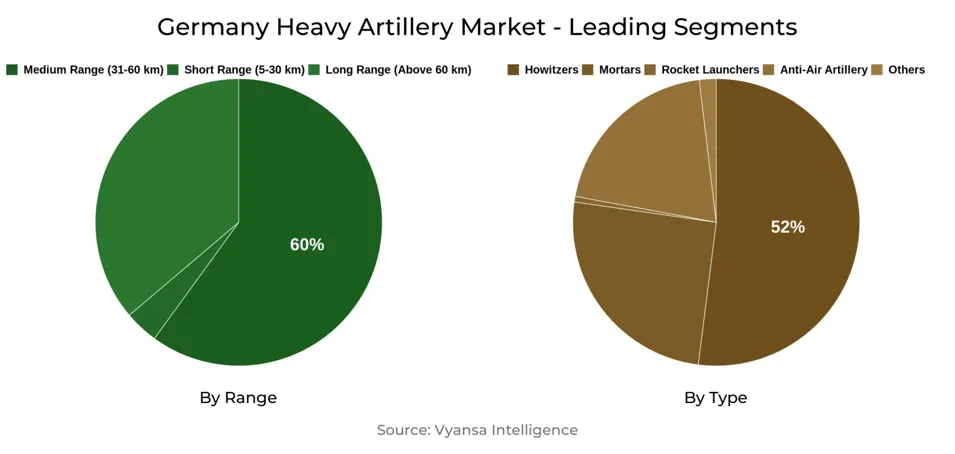
Germany Heavy Artillery Market Report: Trends, Growth and Forecast (2026-2032)
By Range (Short Range (5-30 km), Medium Range (31-60 km), Long Range (Above 60 km)), By Type (Howitzers, Mortars, Rocket Launchers, Anti-Air Artillery, Others), By Platform (Self-Propelled Artillery, Towed Artillery, Navel Artillery, Coastal Artillery), By Components (Fire Control Systems, Ammunition, Gun Systems, Turret Systems, Chassis, Auxiliary Equipment)
- Aerospace & Defense
- Nov 2025
- VI0416
- 130
-




Germany Heavy Artillery Market Statistics and Insights, 2026
- Market Size Statistics
- Heavy Artillery Market in Germany is estimated at $ 1.32 Billion.
- The market size is expected to grow to $ 2.21 Billion by 2032.
- Market to register a CAGR of around 7.64% during 2026-32.
- Range Shares
- Medium Range (31-60 km) grabbed market share of 60%.
- Competition
- More than 10 companies are actively engaged in producing Heavy Artillery Market in Germany.
- Top 5 companies acquired 85% of the market share.
- Renk AG, Heckler & Koch, ST Engineering, Rheinmetall AG, KNDS Deutschland (KMW) etc., are few of the top companies.
- Type
- Howitzers grabbed 52% of the market.
Germany Heavy Artillery Market Outlook
The Germany heavy artillery market currently stands at USD 1.32 billion and is expected to grow to nearly USD 2.21 billion by 2032, with constant growth over the forecast period. It is driven by rising demand for advanced artillery systems and Germany's emphasis on developing its defense capabilities. The growth in the market also indicates continuous investment in new procurement as well as upgrading existing systems.
On the competition front, the largest five players dominate approximately 85% of the market share. This is an emblem of robust dominance by established defense producers, which continue to win large-scale contracts and enjoy long-term ties with the government.
From the point of view of product segmentation, howitzers segment is at the forefront with 52% market share, based on their combination of range, mobility, and responsiveness on the battlefield. Their extensive application sees them as a focal point for Germany's artillery modernization programs.
For the overall period 2026–2032, the future is looked at as an expanding and competitive industry where incumbent companies will take advantage of demand, especially in the case of the howitzer segment, while niche players can ride opportunities in special systems and component provision. This provides consistent momentum for the industry during the period under forecast.

Germany Heavy Artillery Market Growth Driver
Geopolitical Tensions Driving Demand
Geopolitical tensions within Europe are driving greater demand for heavy artillery within Germany. Increasing instability within the region has led the government to place greater emphasis on fortifying its defense systems, with an eye towards artillery reserves. In June 2024, Germany ordered in bulk some 200,000 more 155 mm shells from Rheinmetall worth close to USD 103.83 million. This reflects the direct manner in which security issues are translating into larger procurement levels for domestic producers.
Meanwhile, defense corporations are increasing output to cater to this exigent demand. For instance, Rheinmetall is increasing its Unterlüß facility, which will contribute up to 350,000 artillery shells every year by 2027. In addition to this, Germany's commitment to raise its defense budget to 3.5% of GDP by 2029 guarantees robust economic support. All these combined are propelling consistent growth in the nation's heavy artillery market.
Germany Heavy Artillery Market Challenge
Budgetary Constraints and Lengthy Procurement Cycles Impeding Growth
Budgetary limitations and long procurement cycles continue to be a key challenge for the Germany heavy artillery market. Although Berlin has established a special defense fund and committed increased military expenditures, most of the budget is locked into long-term commitments. This hampers the availability of funds for immediate investment into the expansion of artillery programs, hindering the speed of modernization and new acquisitions.
Besides, German procurement is commonly lengthy and complicated, with a series of approval steps, parliamentary checks, and meticulous compliance procedures. Such bureaucratic hurdles slow down the award of contracts and increase delivery times, causing Rheinmetall and KNDS to wait longer before they collect their revenues. As a consequence, planning for production becomes inefficient, cost overruns occur, and the general responsiveness of the heavy artillery market to emergency demands is reduced.
Germany Heavy Artillery Market Trend
Automation and Smart Fire Systems Shaping Market Dynamics
Automation and smart fire control systems are becoming a prominent trend in Germany's heavy artillery market, as the Bundeswehr focuses on quicker targeting, improved accuracy, and a reduced crew workload. Old systems take more time to set up and need manual adjustments, but new digital fire control supports real-time processing of data, networked targeting, and accurate strikes. This not only makes the battlefield more efficient but also reduces wastage of ammunition, a significant point following Germany's recent attempt at restocking quantities. The drive towards automated systems mirrors the increased need for efficiency and dependability in contemporary artillery systems.
Market participants are seizing the opportunity by upgrading platforms and combining cutting-edge technologies. Rheinmetall, for example, is modernizing the PzH 2000 and creating new fire control software to enhance velocity and accuracy. KNDS Deutschland is also eyeing automation and digitization of modular artillery platforms. These advancements enhance German defense capability and sustain long-term export prospects.
Germany Heavy Artillery Market Opportunity
Wheeled Self-Propelled Howitzers Offering Lucrative Opportunity
Germany is adding wheeled self-propelled howitzers to its defense arsenal as a means of enhancing mobility, reducing maintenance expenses, and providing faster deployment of artillery firepower. In contrast to tracked systems, wheeled systems like the RCH 155 provide higher operational flexibility on Germany's road infrastructure and in expedited deployment missions with NATO. The move is an opportunity since it enables the Bundeswehr to diversify its artillery fleet using more mobile systems while lessening logistical weights.
Market participants are making the most of this by mapping new product creation to Germany's purchasing plans. KNDS Deutschland is taking the lead with the RCH 155 program, backed by orders for more than 160 units, while Rheinmetall is providing important 155 mm ammunition. Concurrently, system integrators such as HENSOLDT are integrating advanced vision and fire control technologies, which support the modernization of Germany's artillery capabilities while creating export routes to allied countries.
Germany Heavy Artillery Market Segmentation Analysis

By Range
- Short Range (5-30 km)
- Medium Range (31-60 km)
- Long Range (Above 60 km)
The segment with the highest market share under the Range is the Medium Range (31–60 km) category, which accounted for nearly 60% of the market. This dominance comes as Germany focuses on systems that balance range, mobility, and cost-efficiency, making them suitable for rapid deployment and allied operations. Medium-range artillery meets both defensive and cooperative NATO mission requirements, driving its adoption across the country’s modernization programs.
Meanwhile, the long-range and short-range segments continue to hold smaller shares, as their use is limited to more specialized missions. Long-range systems are important for precision and extended strike, but they involve higher investment and fewer deployments. Short-range options, on the other hand, are gradually being replaced or upgraded. Overall, medium-range artillery remains the preferred choice for Germany, shaping procurement priorities and guiding investments by major defense firms.
By Type
- Howitzers
- Mortars
- Rocket Launchers
- Anti-Air Artillery
- Others
The most market-share commanding segment under the Type is the Howitzers segment, and it held about 52% of the Germany heavy artillery market. This dominance stems from their versatility in offensive and defensive capacities, with flexible firing ability and high effectiveness on diverse terrains. Howitzers have been a central area of emphasis in the modernization strategy in Germany due to their compatibility with NATO and reliable battlefield performance.
Other units, including rocket artillery and mortars, claim smaller percentages, used primarily in specialized missions or complementary fire support. Mortars are mobile for infantry units but do not have the capability of howitzers, while rocket artillery delivers strong hits but at greater operating expense. Therefore, howitzers are the favored type within Germany, influencing procurement decisions and fortifying the market share of dominant defense producers.
Top Companies in Germany Heavy Artillery Market
The top companies operating in the market include Renk AG, Heckler & Koch, ST Engineering, Rheinmetall AG, KNDS Deutschland (KMW), Diehl Defence, Hensoldt AG, MBDA Deutschland, Lockheed Martin, L3Harris Technologies, etc., are the top players operating in the Germany Heavy Artillery Market.
Frequently Asked Questions
Related Report
1. Market Segmentation
1.1. Research Scope
1.2. Research Methodology
1.3. Definitions and Assumptions
2. Executive Summary
3. Germany Heavy Artillery Market Policies, Regulations, and Standards
4. Germany Heavy Artillery Market Dynamics
4.1. Growth Factors
4.2. Challenges
4.3. Trends
4.4. Opportunities
5. Germany Heavy Artillery Market Statistics, 2022-2032F
5.1. Market Size & Growth Outlook
5.1.1.By Revenues in US$ Million
5.2. Market Segmentation & Growth Outlook
5.2.1.By Range
5.2.1.1. Short Range (5-30 km)- Market Insights and Forecast 2022-2032, USD Million
5.2.1.2. Medium Range (31-60 km)- Market Insights and Forecast 2022-2032, USD Million
5.2.1.3. Long Range (Above 60 km)- Market Insights and Forecast 2022-2032, USD Million
5.2.2.By Type
5.2.2.1. Howitzers- Market Insights and Forecast 2022-2032, USD Million
5.2.2.2. Mortars- Market Insights and Forecast 2022-2032, USD Million
5.2.2.3. Rocket Launchers- Market Insights and Forecast 2022-2032, USD Million
5.2.2.4. Anti-Air Artillery- Market Insights and Forecast 2022-2032, USD Million
5.2.2.5. Others- Market Insights and Forecast 2022-2032, USD Million
5.2.3.By Platform
5.2.3.1. Self-Propelled Artillery- Market Insights and Forecast 2022-2032, USD Million
5.2.3.2. Towed Artillery- Market Insights and Forecast 2022-2032, USD Million
5.2.3.3. Navel Artillery- Market Insights and Forecast 2022-2032, USD Million
5.2.3.4. Coastal Artillery- Market Insights and Forecast 2022-2032, USD Million
5.2.4.By Components
5.2.4.1. Fire Control Systems- Market Insights and Forecast 2022-2032, USD Million
5.2.4.2. Ammunition- Market Insights and Forecast 2022-2032, USD Million
5.2.4.3. Gun Systems- Market Insights and Forecast 2022-2032, USD Million
5.2.4.4. Turret Systems- Market Insights and Forecast 2022-2032, USD Million
5.2.4.5. Chassis- Market Insights and Forecast 2022-2032, USD Million
5.2.4.6. Auxiliary Equipment- Market Insights and Forecast 2022-2032, USD Million
5.2.5.By Competitors
1.1.1.1. Competition Characteristics
1.1.1.2. Market Share & Analysis
6. Germany Short Range (5-30 km) Heavy Artillery Market Statistics, 2022-2032F
6.1. Market Size & Growth Outlook
6.1.1.By Revenues in US$ Million
6.2. Market Segmentation & Growth Outlook
6.2.1.By Type- Market Insights and Forecast 2022-2032, USD Million
6.2.2.By Platform- Market Insights and Forecast 2022-2032, USD Million
6.2.3.By Components- Market Insights and Forecast 2022-2032, USD Million
7. Germany Medium Range (31-60 km) Heavy Artillery Market Statistics, 2022-2032F
7.1. Market Size & Growth Outlook
7.1.1.By Revenues in US$ Million
7.2. Market Segmentation & Growth Outlook
7.2.1.By Type- Market Insights and Forecast 2022-2032, USD Million
7.2.2.By Platform- Market Insights and Forecast 2022-2032, USD Million
7.2.3.By Components- Market Insights and Forecast 2022-2032, USD Million
8. Germany Long Range (Above 60 km) Heavy Artillery Market Statistics, 2022-2032F
8.1. Market Size & Growth Outlook
8.1.1.By Revenues in US$ Million
8.2. Market Segmentation & Growth Outlook
8.2.1.By Type- Market Insights and Forecast 2022-2032, USD Million
8.2.2.By Platform- Market Insights and Forecast 2022-2032, USD Million
8.2.3.By Components- Market Insights and Forecast 2022-2032, USD Million
9. Competitive Outlook
9.1. Company Profiles
9.1.1.Rheinmetall AG
9.1.1.1. Business Description
9.1.1.2. Product Portfolio
9.1.1.3. Collaborations & Alliances
9.1.1.4. Recent Developments
9.1.1.5. Financial Details
9.1.1.6. Others
9.1.2.KNDS Deutschland (KMW)
9.1.2.1. Business Description
9.1.2.2. Product Portfolio
9.1.2.3. Collaborations & Alliances
9.1.2.4. Recent Developments
9.1.2.5. Financial Details
9.1.2.6. Others
9.1.3.Diehl Defence
9.1.3.1. Business Description
9.1.3.2. Product Portfolio
9.1.3.3. Collaborations & Alliances
9.1.3.4. Recent Developments
9.1.3.5. Financial Details
9.1.3.6. Others
9.1.4.Hensoldt AG
9.1.4.1. Business Description
9.1.4.2. Product Portfolio
9.1.4.3. Collaborations & Alliances
9.1.4.4. Recent Developments
9.1.4.5. Financial Details
9.1.4.6. Others
9.1.5.MBDA Deutschland
9.1.5.1. Business Description
9.1.5.2. Product Portfolio
9.1.5.3. Collaborations & Alliances
9.1.5.4. Recent Developments
9.1.5.5. Financial Details
9.1.5.6. Others
9.1.6.Renk AG
9.1.6.1. Business Description
9.1.6.2. Product Portfolio
9.1.6.3. Collaborations & Alliances
9.1.6.4. Recent Developments
9.1.6.5. Financial Details
9.1.6.6. Others
9.1.7.Heckler & Koch
9.1.7.1. Business Description
9.1.7.2. Product Portfolio
9.1.7.3. Collaborations & Alliances
9.1.7.4. Recent Developments
9.1.7.5. Financial Details
9.1.7.6. Others
9.1.8.ST Engineering
9.1.8.1. Business Description
9.1.8.2. Product Portfolio
9.1.8.3. Collaborations & Alliances
9.1.8.4. Recent Developments
9.1.8.5. Financial Details
9.1.8.6. Others
9.1.9. Lockheed Martin
9.1.9.1. Business Description
9.1.9.2. Product Portfolio
9.1.9.3. Collaborations & Alliances
9.1.9.4. Recent Developments
9.1.9.5. Financial Details
9.1.9.6. Others
9.1.10. L3Harris Technologies
9.1.10.1. Business Description
9.1.10.2. Product Portfolio
9.1.10.3. Collaborations & Alliances
9.1.10.4. Recent Developments
9.1.10.5. Financial Details
9.1.10.6. Others
10. Disclaimer
| Segment | Sub-Segment |
|---|---|
| By Range |
|
| By Type |
|
| By Platform |
|
| By Components |
|
Research Methodology
This study followed a structured approach comprising four key phases to assess the size and scope of the electro-oxidation market. The process began with thorough secondary research to collect data on the target market, related markets, and broader industry context. These findings, along with preliminary assumptions and estimates, were then validated through extensive primary research involving industry experts from across the value chain. To calculate the overall market size, both top-down and bottom-up methodologies were employed. Finally, market segmentation and data triangulation techniques were applied to refine and validate segment-level estimations.
Secondary Research
The secondary research phase involved gathering data from a wide range of credible and published sources. This step helped in identifying industry trends, defining market segmentation, and understanding the market landscape and value chain.
Sources consulted during this phase included:
- Company annual reports, investor presentations, and press releases
- Industry white papers and certified publications
- Trade directories and market-recognized databases
- Articles from authoritative authors and reputable journals
- Gold and silver standard websites
Secondary research was critical in mapping out the industry's value chain and monetary flow, identifying key market segments, understanding regional variations, and tracking significant industry developments.
Other key sources:
- Financial disclosures
- Industry associations and trade bodies
- News outlets and business magazines
- Academic journals and research studies
- Paid industry databases
Primary Research
To validate secondary data and gain deeper market insights, primary research was conducted with key stakeholders across both the supply and demand sides of the market.
On the demand side, participants included decision-makers and influencers from end-user industries—such as CIOs, CTOs, and CSOs—who provided first-hand perspectives on market needs, product usage, and future expectations.
On the supply side, interviews were conducted with manufacturers, industry associations, and institutional participants to gather insights into current offerings, product pipelines, and market challenges.
Primary interviews provided critical inputs such as:
- Market size and revenue data
- Product and service breakdowns
- Market forecasts
- Regional and application-specific trends
Stakeholders consulted included:
- Leading OEM and solution providers
- Channel and distribution partners
- End users across various applications
- Independent consultants and industry specialists
Market Size Estimation and Data Triangulation
- Identifying Key Market Participants (Secondary Research)
- Goal: To identify the major players or companies in the target market. This typically involves using publicly available data sources such as industry reports, market research publications, and financial statements of companies.
- Tools: Reports from firms like Gartner, Forrester, Euromonitor, Statista, IBISWorld, and others. Public financial statements, news articles, and press releases from top market players.
- Extracting Earnings of Key Market Participants
- Goal: To estimate the earnings generated from the product or service being analyzed. This step helps in understanding the revenue potential of each market player in a specific geography.
- Methods: Earnings data can be gathered from:
- Publicly available financial reports (for listed companies).
- Interviews and primary data sources from professionals, such as Directors, VPs, SVPs, etc. This is especially useful for understanding more nuanced, internal data that isn't publicly disclosed.
- Annual reports and investor presentations of key players.
- Data Collation and Development of a Relevant Data Model
- Goal: To collate inputs from both primary and secondary sources into a structured, data-driven model for market estimation. This model will incorporate key market KPIs and any independent variables relevant to the market.
- Key KPIs: These could include:
- Market size, growth rate, and demand drivers.
- Industry-specific metrics like market share, average revenue per customer (ARPC), or average deal size.
- External variables, such as economic growth rates, inflation rates, or commodity prices, that could affect the market.
- Data Modeling: Based on this data, the market forecasts are developed for the next 5 years. A combination of trend analysis, scenario modeling, and statistical regression might be used to generate projections.
- Scenario Analysis
- Goal: To test different assumptions and validate how sensitive the market is to changes in key variables (e.g., market demand, regulatory changes, technological disruptions).
- Types of Scenarios:
- Base Case: Based on current assumptions and historical data.
- Best-Case Scenario: Assuming favorable market conditions, regulatory environments, and technological advancements.
- Worst-Case Scenario: Accounting for adverse factors, such as economic downturns, stricter regulations, or unexpected disruptions.
Partnering With Industry Leaders to Drive Growth
Our mission is to deliver intelligence that matters. By combining data, analysis, and industry expertise, we enable organizations to make smarter, faster, and more impactful decisions. Whether it’s a Fortune 500 company or a high-growth startup, businesses trust us to provide clarity in an ever-evolving marketplace.






